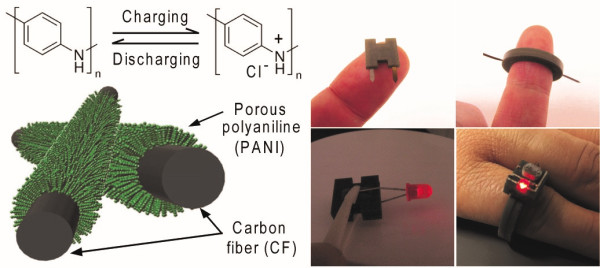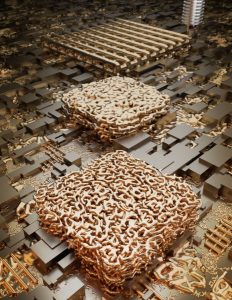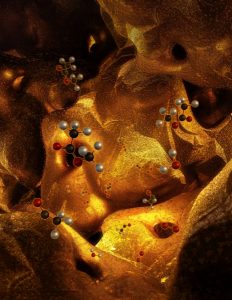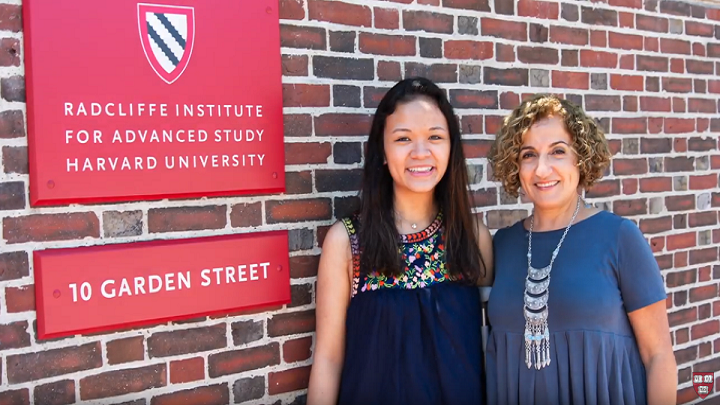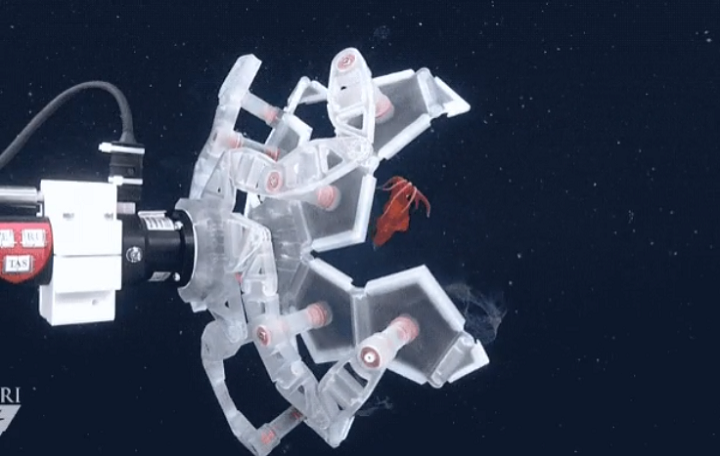Researchers 3D Print a New Variety of Zinc Ion Battery Shapes for Wearable Devices
With the development of flexible wearable devices comes the need for new battery shapes, as most batteries are currently limited to spherical or rectangular shapes. These shapes do not use space as efficiently as other shapes could, so a team of researchers led by Professor Il-Doo Kim from the Department of Materials Science at KAIST and Professor Jennifer Lewis from the School of Engineering and Applied Sciences at Harvard University have used 3D printing to manufacture batteries with a variety of novel shapes.
These shapes include ring-type, H and U-shaped batteries. Through a research collaboration with Dr. Youngmin Choi at the Korea Research Institute of Chemical Technology (KRICT), these 3D printed batteries were applied to small wearable electronic devices, namely wearable light sensor rings.
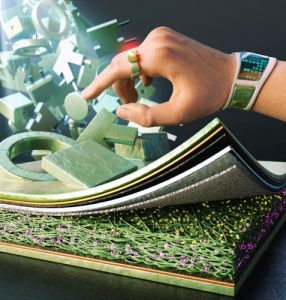 The team adapted environmentally friendly aqueous Zn-ion batteries to make customized battery packs. The system, which uses Zn2+ instead of Li+ as charge carriers, is much safer than rechargeable lithium batteries, which use highly flammable organic electrolytes. The processing conditions of these lithium-ion batteries is also highly complicated, as organic solvents can ignite upon exposure to moisture and oxygen. The aqueous Zn-ion batteries are stable upon contact with atmospheric moisture and oxygen, so they can be fabricated in ambient air conditions. They also have advantages in packaging, since packaged plastic does not dissolve in water even when 3D printed.
The team adapted environmentally friendly aqueous Zn-ion batteries to make customized battery packs. The system, which uses Zn2+ instead of Li+ as charge carriers, is much safer than rechargeable lithium batteries, which use highly flammable organic electrolytes. The processing conditions of these lithium-ion batteries is also highly complicated, as organic solvents can ignite upon exposure to moisture and oxygen. The aqueous Zn-ion batteries are stable upon contact with atmospheric moisture and oxygen, so they can be fabricated in ambient air conditions. They also have advantages in packaging, since packaged plastic does not dissolve in water even when 3D printed.
The researchers used an electrospinning process to fabricate a carbon fiber current collector and uniformly coated electrochemically active polyaniline conductive polymer on the surface of the carbon fiber for a current collector-active layer integrated cathode. The cathode, which is based on conductive polyaniline consisting of a 3D structure, exhibits extremely fast charging speeds, with 50 percent of the charge being completed in two minutes. It can be fabricated without the detachment of active cathode materials, so various battery forms with high mechanical stability can be manufactured.
“Zn-ion batteries employing aqueous electrolytes have the advantage of fabrication under ambient conditions, so it is easy to fabricate the customized battery packs using 3D printing,” said Professor Kim.
The research was published in a paper entitled “High-Power Aqueous Zinc-Ion Batteries for Customized Electric Devices.“
“3D-printed batteries can be easily applied for niche applications such as wearable, personalized, miniaturized micro-robots, and implantable medical devices or microelectronic storage devices with unique designs,” said Professor Lewis.
Most current battery shapes are optimized for coin cell or pouch cells. Since batteries occupy most of the space within microelectronic devices, different shapes are required to fit the new wider variety of devices. The researchers’ success could lead to more of a variety of wearable devices, including very small ones.
In related news, Professor Kim was appointed as an Associate Editor of ACS Nano, in which the article was recently published.
“It is my great honor to be an Associate Editor of the highly renowned journal ACS Nano, which has an impact factor reaching 13.709 with 134,596 citations as of 2017,” he said. “Through the editorial activities in the fields of energy, I will dedicate myself to improving the prominence of KAIST and expanding the scope of Korea’s science and technology. I will also contribute to carrying out more international collaborations with world-leading research groups.”
Authors of the paper include Chanhoon Kim, Bok Yeop Ahn, Teng-Sing Wei, Yejin Jo, Sunho Jeong, Youngmin Choi, Ill-Do Kim and Jennifer A. Lewis.
Discuss this and other 3D printing topics at 3DPrintBoard.com or share your thoughts below.
[Source/Images: KAIST]
Wyss Institute applies “try before you buy” initiative to 3D printed heart valves
FDA awards $2.6M in grants for 3D bioprinting and biomedical research
Lawrence Livermore National Laboratory Makes 3D Printed Nanoporous Gold That Could Change the Design of Electrochemical Reactors
Lawrence Livermore National Laboratory (LLNL) is known for doing impressive work with materials, particularly related to 3D printing. Whether it’s nanoscale 3D printing or 3D printed glass, the organization is constantly making new discoveries. In its latest study, entitled “Toward digitally controlled catalyst architectures: Hierarchical nanoporous gold via 3D printing,” LLNL researchers along with those from Harvard University discuss the hierarchical printing of nanoporous gold. According to the researchers, this work could have a major impact on the design of chemical reactors.
Nanoporous metals are strong catalysts for chemical reactions, as they have a large surface area and high electrical conductivity. This makes them well-suited to applications such as electrochemical reactors, sensors and actuators.
“If you consider traditional machining processes, it’s time consuming and you waste a lot of materials — also, you don’t have the capability to create complex structures,” said LLNL postdoctoral researcher Zhen Qi, a co-author on the paper. “By using 3D printing we can realize macroporous structures with application-specific flow patterns. By creating hierarchical structures, we provide pathways for fast mass transport to take full advantage of the large surface area of nanoporous materials. It’s also a way to save materials, especially precious metals.”
The researchers combined an extrusion-based direct ink writing process with an alloying and dealloying process to engineer nanoporous gold into three distinct scales, from the microscale to the nanoscale. According to the team, the hierarchical structure “dramatically improves mass transport and reaction rates for both liquid and gases.” Being able to manipulate the catalyst’s surface area to generate electrochemical reactions through 3D printing could have a big impact on electrochemical plants, which currently rely mostly on thermal energy.
“By controlling the multiscale morphology and surface area of 3D porous materials, you can start to manipulate the mass transport properties of these materials,” said LLNL researcher Eric Duoss. “With hierarchal structures you have channels that can handle transfer of reactants and products for different reactions. It’s like transportation systems, where you go from seven-lane expressways down to multiple lane highways to thoroughfares and side streets, but instead of transporting vehicles we’re transporting molecules.”
LLNL researcher Cheng Zhu and former postdoctoral student Wen Chen made inks out of gold and silver nanoparticles, which were then 3D printed. The printed parts were placed into a furnace to allow the particles to coalesce into a gold-silver alloy. The team then put the parts into a chemical bath that removed the silver in a process called dealloying, leaving porous gold behind.
“The final part is a 3D hierarchical gold architecture comprising the macroscale printed pores and the nanoscale pores that result from dealloying,” said Chen, who is currently a professor at the University of Massachusetts-Amherst. “Such hierarchical 3D architectures allow us to digitally control the morphology of the macropores, which allowed us to realize the desired rapid mass transport behavior.”
According to Zhu and Chen, the method can also be applied to other metals such as magnesium, nickel and copper, opening up 3D printing applications in fields such as catalysis, batteries, supercapacitors and carbon dioxide reduction.
The challenge in catalysis, according to LLNL researcher Juergen Biener, is in combining high surface area with rapid transport.
“While additive manufacturing is an ideal tool to create complex macroscale structures, it remains extremely difficult to directly introduce the nanostructures that provide the required high surface area,” Biener said. “We overcame this challenge by developing a metallic ink-based approach that allowed us to introduce nanoporosity through a selective corrosion process called dealloying.”
Biener said that the team’s extrusion-based approach is universal and scalable, provides tooling-free control over the macroscopic sample shape, and enables integration of nanoporosity in an application-specific engineered macroporous network structure. These advantages open new design possibilities for chemical reactor and energy storage and conversion devices.
The project is part of a feasibility study into a proposed strategic initiative to create 3D electrochemical reactors in which scientists could have greater control over catalysts and reduce transport limitations. Instead of large electrochemical plants, which are located near oil refineries or in remote areas, modular reactor networks could be created in a series that could be easily replaceable and transportable to locations near sources of abundant renewable energy or carbon dioxide.
“There are a whole lot of scientific and engineering challenges left, but it could have significant impact,” said Chris Spadaccini, director of LLNL’s Center for Engineered Materials and Manufacturing. “Scaling up should be easier with small-scale reactors because you can parallelize. You could have an array of small 3D reactors together instead of one large vessel enabling you to control the chemical reaction process more effectively.”
The researchers are also starting to explore other materials that could be catalysts for other reactions.
Authors of the paper include Cheng Zhu, Zhen Qi, Victor A. Beck, Mathilde Luneau, Judith Lattimer, Wen Chen, Marcus A. Worsley, Jianchao Ye, Eric B. Duoss, Christopher M. Spadaccini, Cynthia M. Friend and Juergen Biener.
Discuss this and other 3D printing topics at 3DPrintBoard.com or share your thoughts below.
[Source: Newswise]
Harvard Fellowship Brings Professor and Student Together to Work on 3D Printed Artificial Bone Implants
 Growing up in Jordan, University of Sydney biomedical engineering professor Hala Zreiqat, a 2016-2017 Research Fellow at Harvard University’s Radcliffe Institute for Advanced Study, originally wanted to be an interior designer, but due to the impracticality of studying the subject in the UK, she graduated with a degree in biology because, as she told the Radcliffe Magazine last year, science “is a bit of art.”
Growing up in Jordan, University of Sydney biomedical engineering professor Hala Zreiqat, a 2016-2017 Research Fellow at Harvard University’s Radcliffe Institute for Advanced Study, originally wanted to be an interior designer, but due to the impracticality of studying the subject in the UK, she graduated with a degree in biology because, as she told the Radcliffe Magazine last year, science “is a bit of art.”
Professor Zreigat eventually moved to Australia to pursue her own medical research, and focused her PhD thesis at the University of New South Wales Medical School on making a titanium alloy used in hip replacements more biologically compatible. Later, she established the University of Sydney’s first tissue-engineering lab, while also building an international network of scientists, clinicians, and engineers. Her goal is to provide better treatment options, through the use of substitute bone able to easily incorporate itself into the body, for the millions of people worldwide who suffer bone loss, because metal was never meant to be part of our bodies.
Professor Zreigat asked, “You can have a material that has brilliant mechanical properties, but if it doesn’t do what you want it to do with cells in the body, what’s the point?”
One of these millions of people with bone loss is Linh Nam, a current Harvard College student and Professor Zreigat’s Summer Radcliffe Research Partner.
“When I found out I was hired by Hala to be part of this project, I was really excited and was really looking forward to working with her and hearing from her perspective and contributing my part to this project,” said Nam in a Harvard video.
The project aims to create a biocompatible, artificial material with the same strength and porosity as real bone using 3D printing – a worthy goal shared by many other researchers around the world.
Professor Zreigat said, “The bone substitute my team and I developed is similar in structure and composition to actual bone; mimics the way real bone withstands loads and deflects impacts; and, like real bone, contains pores that allow blood and nutrients to penetrate it.
“The fact that our material actually kick-starts bone regeneration makes it far superior to other available materials. Each patient has only a limited amount of bone available for grafting, so the demand for synthetic bone substitutes is high.”
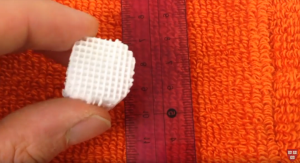 As of last year, Professor Zreigat’s team had found a way to generate a porous core of a novel multi-component ceramic using 3D printing. The material is infused with trace elements that are necessary for the formation of bones, like zinc, calcium, and strontium, and is also a good candidate for successfully bridging damaged vertebrae in spinal fusion surgery.
As of last year, Professor Zreigat’s team had found a way to generate a porous core of a novel multi-component ceramic using 3D printing. The material is infused with trace elements that are necessary for the formation of bones, like zinc, calcium, and strontium, and is also a good candidate for successfully bridging damaged vertebrae in spinal fusion surgery.
“I think it’s a great opportunity that Radcliffe has brought us to be able to work together and for me to have this chance to know Hala, who’s a leading expert in her field,” said Nam.
Nam, who is working with Professor Zreiqat to introduce 3D printing to the artificial material for orthopedic applications, explained that she would not be able to have this opportunity elsewhere. But while her talent got her in the door, something else about the young student caught Professor Zreiqat’s eye.
“Linh’s application stood out because of her experience in evolution biology,” Professor Zreiqat explained. “I recall when I read her application that there was osteosarcoma in it, but that’s not what really attracted me to Linh’s. And when she walked into my office she was on crutches, and that’s when I’m going, oh my goodness, that’s the one with osteosarcoma, which is cancer of the bones. And I looked at Linh and she had these long surgical marks on her tibia and femur and that’s when I thought it could not have been a better match of having Linh working on the material.”
Nam was diagnosed with osteosarcoma – a cancerous tumor in the bone – when she was just ten years old, and had to have a section of bone removed from her leg,” which, as Nam explained, left “the question of what could be put into that gap.”
Bone from a bone bank was used to fill in the gap left by removing the original bone, and a metal plate was added to hold everything together. According to Nam, there were a lot of complications stemming from the surgery, including the metal parts coming apart and trouble healing, because the bone in the gap was not her own. All in all, she had ten surgeries over a whole decade.
Nam explained, “So I felt that Hala’s project was really meaningful in the sense that it negates the need for metal for patients that have bone defects.”
Professor Zreiqat is a strong advocate for mentoring the younger generation. She has formed strong bonds with many of her ex-research partners, and hopes that this “will be the case with Linh as well.”
These types of fellowships have also allowed her to get some help from new eyes in forging ahead with her innovative research.
“I’m hoping for this medical technology to reach to the patient as close as 2019, and we’re very, very close to that.”
Discuss this story and other 3D printing topics at 3DPrintBoard.com or share your thoughts in the Facebook comments below.
3D Printed Origami Device Safely Traps Soft-Bodied Sea Creatures for Study
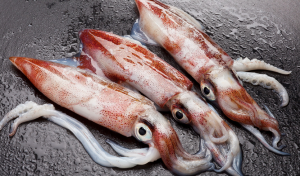 Many 3D printing applications and innovations, like self-folding objects, robots, and face masks, have been inspired by the Japanese paper folding art of origami. Now, a collaborative group of scientists from Harvard University, the University of Rhode Island, and City University of New York (CUNY) have combined the principles of 3D printing and origami to find a less damaging way to capture delicate, soft-bodied sea creatures like squids, anemones, and jellyfish.
Many 3D printing applications and innovations, like self-folding objects, robots, and face masks, have been inspired by the Japanese paper folding art of origami. Now, a collaborative group of scientists from Harvard University, the University of Rhode Island, and City University of New York (CUNY) have combined the principles of 3D printing and origami to find a less damaging way to capture delicate, soft-bodied sea creatures like squids, anemones, and jellyfish.
While soft forms like these are adapted to ocean pressures, it’s hard to catch them for the purposes of study without injuring the very subjects you want to learn more about. Marine biologist David Gruber, who helped design the capture device, says that these creatures are often called the “forgotten fauna” because their study has been so neglected. But the multi-university research team recently introduced its 3D printed, 12-sided trap, inspired by origami, that can fold around these animals gently, without harming them.
The RAD device, which is short for rotary actuated dodecahedron, is far better equipped for handling these delicate creatures than nets or suction samplers. It can be attached to the arm of an underwater rover, then triggered remotely, and has already successfully trapped jellyfish and small squid and octopuses at a depth of 700 meters. However, the design can work at depths up to 11 kilometres, with the possibility of being scaled up even further for larger creatures.

Still images showing the capture of three different types of soft-bodied sea life using the RAD. [Image: Wyss Institute at Harvard University]
Zhi Ern Teoh, a mechanical engineer at Harvard, said the most important part of the design was getting it to unfold with just one motor so that the system has fewer points of failure. The team had to create a complex series of linkages, lightweight enough so as not to cause motor strain but still able to hold up underwater, which would connect each of the 12 panels back to the motor.
The RAD has several other important design touches, including making the edges of the panels softer than the rest of the plastic device so creatures struggling to get out (which makes me sad to think about but I know it’s important to study these animals so I’ll just get over it) aren’t accidentally amputated. Additionally, there are gaps between each of the panels to pressure doesn’t build up inside when the RAD travels back up to the surface.
“I view this as a platform technology that we hope will continue to evolve. The dream is to enclose delicate deep-sea animals, take 3D imagery that includes properties like hardness, 3D-print that animal at the surface, and also have a ‘toothbrush’ tickle the organism to obtain its full genome. Then, we’d release it,” Gruber told the Verge.
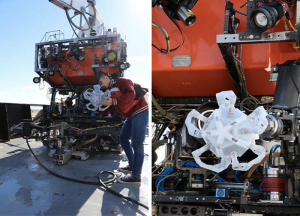
L-R: Zhi Ern Teoh inspects the RAD when attached to an underwater rover; a closeup of the RAD folded shut. [Image: Kaitlyn Becker, Wyss Institute at Harvard]
The basic RAD organism, as previously mentioned, can be scaled up for the capture of larger species, and Teoh even says it could one day be possible to develop a version that’s human-sized, which could have applications in self-building habitats in outer space. In addition, the current remote-controlled RAD could be turned into an automated trap in the future that uses sensors to detect when a creature is passing by.
3D printing has helped us sample the floor of the ocean and clean up debris from its shores, give coral reefs a helping hand, and quietly observe marine life. Now, this basic 3D printed origami mechanism can help us safely capture soft-bodied organisms for the purposes of study.
Gruber believes, and I tend to agree, that this kind of advanced technology is absolutely imperative to exploring our oceans without causing further harm to the myriad creatures that call them home. We are only just scratching the surface when it comes to figuring out just how important of a role marine life – from the tiniest sea cucumber to the most massive of coral reefs – can play in the overall ecosystem of the ocean.
The team published a paper on their development of the RAD in the Science Robotics journal, which you can read here. Co-authors are Teoh, Brennan T. Phillips, Kaitlyn P. Becker, Griffin Whittredge, James C. Weaver, Chuck Hoberman, Gruber, and Robert J. Wood.
Discuss this and other 3D printing topics at 3DPrintBoard.com or share your thoughts below.

